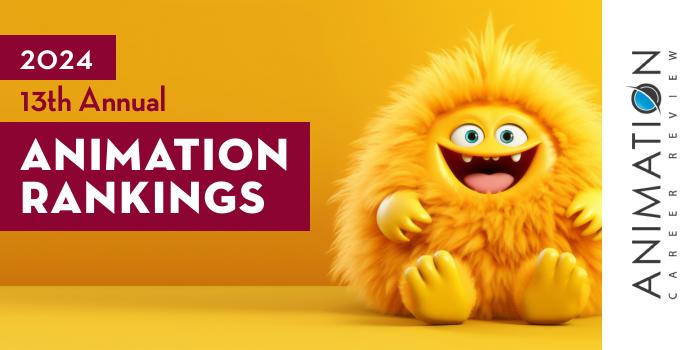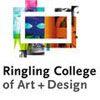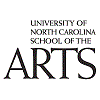
Become a 3D animator for film and games! Get specialized training to fast-track your career with CG Spectrum’s online 3D animation courses. Learn directly from expert animators working on hit films and best-selling games. Find out more.

| Ranking | School | State |
|---|---|---|
| 1 | Savannah College of Art and Design | Georgia |
| 2 | Ringling College of Art and Design | Florida |
| 3 | Full Sail University | Florida |
| 4 | University of Central Florida | Florida |
| 5 | Florida State University | Florida |
| 6 | Clemson University | South Carolina |
| 7 | University of Florida | Florida |
| 8 | University of North Carolina School of the Arts | North Carolina |
| 9 | Middle Tennessee State University | Tennessee |
| 10 | The Digital Animation & Visual Effects School | Florida |
| 11 | North Carolina State University | North Carolina |
| 12 | Lipscomb University | Tennessee |
| 13 | East Tennessee State University | Tennessee |
| 14 | University of South Florida | Florida |
| 15 | Tulane University | Louisiana |
| 16 | Louisiana State University | Louisiana |
| 17 | University of South Carolina | South Carolina |
| 18 | East Carolina University | North Carolina |
| 19 | Kennesaw State University | Georgia |
| 20 | University of Tampa | Florida |
| 21 | University of Alabama in Huntsville | Alabama |
| 22 | University of Louisiana at Lafayette | Louisiana |
| 23 | Louisiana State University, Shreveport | Louisiana |
| 24 | University of North Carolina, Charlotte | North Carolina |
| 25 | Lynn University | Florida |
Our 2024 list -our thirteenth annual- of the Top 25 Animation School Programs in the South. For reference, we define the South as Florida, Georgia, Alabama, Louisiana, North Carolina, South Carolina, Kentucky, West Virginia, Tennessee, Mississippi, Arkansas. For an explanation of ranking criteria, click here.

The School of Animation and Motion at Savannah College of Art and Design (SCAD) houses three Animation degrees, three Visual Effects (VFX) options for students seeking an undergraduate or advanced degree, and the world’s first specialized degree in Motion Media Design. Across programs, students have access to more than 800 networked computers and a state-of-the-art 60,000-square-foot SCAD Digital Media Center, which houses a green screen lab, in-house theater, and studio.
Other program features include instruction from celebrated professors who have worked at major studios and on award-winning productions such as Ice Age, Pocahontas, and The Lion King; participation in SCAD Study Abroad in Lacoste, France, or other location; and SCAD Savannah Film Festival, which highlights special film screenings, celebrity panels, lectures, workshops, and presentations with celebrated industry professionals. SCAD Film Festival is the largest university-run film festival in the world.
For artists seeking an undergraduate or graduate program in Animation, Savannah College of Art and Design has BFA, MA, and MFA degrees in Animation. Available Minors include Animation, Concept Design for Animation and Games, and Animated Illustration and Publication Design. Examples of Minors that complement the Animation programs include Visual Effects, Technical Direction, Storyboarding, Illustration for Entertainment, Interactive Design and Game Development, and Character Technical Direction.
Incoming BFA students may enroll in Gradpath@SCAD, which provides the opportunity to earn a BFA/MA or BFA/MFA at an accelerated pace. Students in the BFA/MA program may complete this combined degree in less than four years. The BFA/MFA can be completed in five years or less.
The 180 credit hour Animation BFA is available at SCAD’s Atlanta and Savannah campuses. The major curriculum for the program consists of 80 credit hours, including concentrations in 2D Animation, 3D Character Animation, Technical Animation, or Storytelling and Concept Development. Students also have the opportunity to select 15 credit hours of free electives. Course examples for the program (and concentrations) include Digital Communication; Visual Culture in Context: Making Modernities; Storyboarding Essentials; Inventing Environments; Collaborative Experiences in Animation, 3D Character Animation: Creatures and Quadrupeds, and Story and Concept: Seeding the Narrative.
Each student in the SCAD Animation BFA program will complete three Film Capstone courses including Preproduction, Production, and Postproduction. An optional internship is also part of the program.
The Animation MA and MFA programs at Savannah College of Art and Design are 45 and 90 credit hours, respectively. The MA is available at the Savannah campus and through the schools online learning platform SCADnow. The MFA is available in Atlanta, Savannah, and via SCADnow. MA students will complete courses such as Animation Aesthetics and Practice; 3D Cartoon Character Animation; Computer-Generated Modeling and Design; 3D Naturalistic Character Animation; Drawing in Motion; and Look Development. Students have the option to complete a graduate internship.
The culminating experience for the SCAD MA program is the School of Animation and Motion MA Final Project. During the course of this experience, students propose, develop, and execute a project that is then cut into their reel.
The Animation MFA at Savannah College of Art and Design consists of courses such as Storyboarding and Previsualization; Computer-Generated Modeling and Design; Drawing in Motion; Animation Aesthetics and Practice; and Media Theory and Application. Completion of at least seven 500- to 700-level electives is part of the program, as well as a required graduate internship and the Animation MFA Thesis.
Across all SCAD Animation programs, graduates are prepared to pursue leadership roles in all areas of Film and Animation. SCAD Animation alumni have been recruited by major studios, gaming companies, and networks such as Pixar, 20th Century Fox, Sony Pictures Imageworks, Electronic Arts (EA), DreamWorks, Cartoon Network, Nickelodeon, Walt Disney Animation Studios, and Lucasfilm Animation. SCAD alumni have worked on Oscar nominated productions such as Encanto (won), Raya and the Last Dragon, Luca, and Turning Red. Many SCAD graduates have also established careers at places such as Microsoft, Adobe, Deloitte, Spotify, and Delta Air Lines.
Founded in 1978, Savannah College of Art and Design opened its doors in the renovated Savannah Volunteer Guards Armory in September 1979. The school began with just one classroom, an administration building, and 71 students. Today, SCAD serves more than 16,000 students across campuses in Atlanta and Savannah, Georgia, and Lacoste, France. SCAD students hail from more than 120 countries and all 50 states.
With more than 100 degree programs and over 75 minors and certificate programs, Savannah College of Art and Design has more degree programs and specializations than any other art and design college in the U.S. Savannah College of Art and Design is accredited by the Southern Association of Colleges and Schools Commission on Colleges (SACSCOC), the Council for Interior Design Accreditation (CIDA), and the National Architecture Accrediting Board (NAAB).

Ringling College of Art and Design (RCAD) has a Computer Animation program that has produced 17 Student Academy Award-winning students since 1998. Established in 1990 and leading to a BFA, the program requires 120 credit hours of study. Courses are taught by accomplished professionals in the field, complemented by interactions with industry guest speakers from major studios such as DreamWorks.
Other program features include internship opportunities; real-world projects with area businesses; visiting artists; and participation in the RCAD initiative INDEX (Industry Experience). Developed in partnership with The Patterson Family Foundation, INDEX provides experiential learning opportunities including everything from additional internships to competitions sponsored by major clients and brands. INDEX also helps students build their resumes and portfolios.
The RCAD Computer Animation BFA requires 120 credit hours, including 48 credit hours in the major and 12 credit hours of open electives. Electives allow students to enhance the curriculum by gaining skills in multiple areas of art and design. Students will take required major courses such as Computer Animation I-VI; Visual Development for Computer Animation I-II; Traditional Animation I-II; Story Development I-II; and Animation Preproduction. The culminating experience for this BFA program is the Thesis Project in Computer Animation.
An additional degree option for individuals looking to launch a career in animation is RCAD’s Motion Design BFA. This program covers animation, design, stop motion, and sound. Motion Design students have access to state-of-the-art Studio 314; opportunities to collaborate on projects in teams; participate in the ART Network Group; and attend the week-long FutureProof conference. This major event consists of presentations, workshops, and other activities designed to enhance the BFA degree. Past speakers have included artists and others from Nickelodeon, Telemundo, Hue&Cry, Hornet, and FutureDeluxe.
The Motion Design BFA requires 120 credit hours, including 39 in the major, 12 (regular electives), and 12 (open electives). Examples of major courses include 2D Animation; 3D Animation; Concept Development I-II; Advanced 2D Animation; Advanced 3D Animation; Design Fundamentals for Motion; and Branding and Visual Systems. Elective examples include Styleframe Development in Motion; Advanced Animation Techniques; Digital Compositing for 3D; Project Mapping; and Advanced Motion Design Techniques I-II.
The Motion Design BFA program at Ringling College of Art and Design culminates with two courses: Senior Project: Production Studio and Senior Project: Experimental (with presentation).
Graduates of the art and design programs at RCAD have won Oscars and many have launched their own studios and freelance businesses. RCAD alumni have worked with major companies and studios around the globe. Examples include Disney, Netflix, Nickelodeon, Universal, Sony, Walt Disney Animation, Google, Apple, Microsoft, Amazon, Hulu, Titmouse, Discovery, LAIKA Studios, Meta, ESPN, MPC, Ubisoft, Ford, Pandora, TikTok, and Feld Entertainment.
Ringling College of Art and Design is a private, not-for-profit college accredited by the National Association of Schools of Art and Design (NASAD) and the Southern Association of Colleges and Schools Commission on Colleges (SACSCOC). Founded in 1931 by Dr. Ludd M. Spivey (then president of Southern College) and circus baron John Ringling, RCAD serves 1,705 students enrolled in 11 different majors leading to a BFA degree, two majors leading to a BA, and minor options in 10 areas.

Full Sail University (Full Sail) sits on a 212-acre campus that houses more than 110 state-of-the-art studios, collaborative production environments, a large Hollywood-style back lot, professional-level recording and game studios, and live venues that host concerts, festivals, and other events.
Full Sail focuses on project-based training, which allows students across majors to gain valuable real-world experience—all before graduation. Full Sail students also have access to the Project LaunchBox, which provides software and tools to create projects. LaunchBox also houses student coursework and files, which can be accessed 24 hours a day, seven days a week.
For students seeking an animation degree, Full Sail University has a Computer Animation program with both online and on-campus tracks. Leading to a BS, the online track takes 29 months to complete. The campus track takes just 20 months to complete. Students in both programs will learn how to navigate the same production pipelines used in today’s major studios.
Course examples for the program include 3D Animation; Technology in the Entertainment and Media Industries; Technical Animation; Compositing and Scene Finishing; Motion Capture; Animation Production; Model Creation; Psychology of Play; Creative Presentation; and Industry Production.
All Full Sail animation students are required to take two professional development seminar courses and seven project and portfolio courses covering 3D arts and computer animation. Additional professional development courses provide the opportunity for students to explore the computer animation industry, while learning to build their personal brand. Industry guest speakers enhance professional development courses.
In addition to hands-on project learning, the project and portfolio courses for the BS program emphasize independent study and portfolio development. A Career Readiness course, completed in the final month of the program, allows students to create a strategy for engaging with potential employers. Throughout the course, students will create their targeted résumés, cover letters, and professional portfolios. This course provides students with the tools needed to apply their research and newly acquired skills toward their employment goals.
Full Sail University graduates are prepared to pursue positions across industries such as animation, film, and television (entertainment); game design and development; advertising and marketing; architecture; science and medicine; data visualization; and forensic animation.
In the entertainment industry, program alumni have been credited on more than 45 Grammy-nominated projects; on 2022 blockbusters such as Pixar’s Lightyear, Jurassic World: Dominion, and Minions: The Rise of Gru; and other productions and series such Obi-Wan Kenobi, Ms. Marvel, and Stranger Things 4.
Full Sail University opened in 1979 in Dayton, Ohio. Today, the school is located just 35 minutes from downtown Orlando and Universal Studios. Serving approximately 21,000 students, Full Sail provides graduate certificates and degree programs at all levels in the Arts, Entertainment, Media, and Technology. Full Sail University is accredited by the Accrediting Commission of Career Schools and Colleges (ACCSC).

The College of Arts and Humanities at the University of Central Florida (UCF) houses the School of Visual Arts & Design (SVAD), home to the Emerging Media Program. Degree options for animators are available at both the undergraduate and graduate levels. The Emerging Media BFA has tracks in Character Animation and Experimental Animation. The MFA in Emerging Media has an Animation and Visual Effects Track.
Character Animation and Experimental Animation are portfolio-based, highly competitive tracks that take place in a studio-environment that mirrors today’s professional studios. Students in both tracks also benefit from faculty mentors; courses taught by industry professionals and in multiple areas such as storytelling, technology, art, and design; access to state-of-the-art production labs; and internship opportunities.
Course examples for the Character Animation track include Advanced 3D Animation; Digital Effects and Compositing; New Imagery in Motion Workshop; 3D Textures; Visual Storytelling and Visual Development; Digital Production in Artificial Environments; and Character Animation Portfolio Review.
Course examples for the Experimental Animation track include Advanced Experimental Animation; Experimental Animation Workshop; Experimental Animation Professional Practice; and Experimental Animation Portfolio. Students in this track will also complete the BFA thesis project with exhibition/screening.
Both BFA tracks allow students to work their way through the production pipeline from story creation to film completion. After completing general education and other program requirements, the Emerging Media tracks take two years to complete, full-time.
The Emerging Media MFA with an Animation & Visual Effects track is a 60 credit hour program that focuses on narrative film structure and the entrepreneurial aspects of animation as it relates to independent filmmaking, studio employment, and job creation. Program benefits include the opportunity to create an animation and/or visual effects thesis using techniques such as stop motion, 2D and 3D computer animation, and traditional hand-drawn; co-directing opportunities; and access to state-of-the-art labs and studios. This competitive program requires 60 credit hours of study, completed over three years, full-time.
Graduates of the Emerging Media programs at University of Central Florida are Animators, Effects Artists, Story Artists, Modelers, Visual Development Artists, Lighting Artists, Riggers, Technical Artists, and Texture Artists. Program alumni are employed with major studios and gaming companies such as Pixar, DreamWorks, Disney, and Electronic Arts (EA).
The College of Sciences at University of Central Florida has an additional option for animators seeking a graduate degree. Housed within the College of Sciences is Nichols School of Communication & Media—home to Florida Interactive Entertainment Academy (FIEA). Established in partnership with the city of Orlando, the state of Florida, and UCF, FIEA enrolls more than 130 students annually.
UCF FIEA has an Interactive Entertainment MS that provides the opportunity for students to compete and internship and work in production teams mentored by industry professionals. These mentors provide instruction in areas such as 3D animation and modeling, software engineering, game design, motion capture, technical art, and creative collaboration.
The Interactive Entertainment MS requires 30 credit hours of study, including 12 credit hours of core courses, nine credit hours in a specialization (Art, Production or Programming), a practicum, and a capstone experience. The Capstone results in a large-scale project that will be presented at a special event for the FIEA community and invited guests.
Graduates of the Florida Interactive Entertainment Academy at University of Central Florida are prepared to pursue careers at major studios across the U.S. and abroad. Program alumni have been hired at companies and studios such as Universal, Blizzard Entertainment, Industrial Light & Magic (ILM), Marvel, Sony, Walt Disney Imagineering, Gameloft, Nintendo, Electronic Arts (EA), DreamWorks, Google, Microsoft Studios, and Zynga.
University of Central Florida opened in 1968 as Florida Technological University. On the first day of classes, the school had less than 2,000 students. Today, UCF serves approximately 68,440 students, making it the largest university by enrollment in the state of Florida, and one of the top 10 largest universities in the U.S. The school provides 243 bachelor’s degrees, 219 master’s degrees, and 81 doctorate degrees across 13 colleges. University of Central Florida is accredited by the Southern Association of Colleges and Schools Commission on Colleges (SACSCOC).

Florida State University (FSU) is home to the College of Motion Picture Arts, which houses a limited access Animation and Digital Arts program. Each class for this BFA program is limited to just nine students. Consisting of 120 credit hours (with 91 in the major), this four year program highlights three years of immersive animation coursework.
Course examples include History & Practice of Visual Effects and Animation; Advanced Filmmaking; Story Development and Screenwriting; Character Art; Lighting, Texturing, and Rendering; Visualization I-III; Character Animation; Film Aesthetics; Reality & Illusion in World Cinema; Character Animation; Motion Picture Editing; Digital Studio Department Leadership; and Production Management. Courses such as the Professional Internship; Portfolio Production; and marketing and Exhibition are provided as electives.
Throughout the Animation and Digital Arts program at FSU will have the opportunity to complete a total of four major films. This includes the Thesis film. All enrolled students in the College of Motion Picture Arts may participate in the Torchlight Program. This option provides instruction in the marketing, financing, and distribution of films.
Graduates of the Animation and Digital Arts BFA program at Florida State University are prepared to pursue positions in the film, television, and animation industries. Potential job titles include Animator, Effects Animator, VFX Artist, Animatics Supervisor, CG Lighter, Animation Supervisor, Modeler, Storyboard Artist, and Rigger.
Founded in 1851 and serving approximately 44,600 students, Florida State University is one of the oldest and largest universities in Florida. The school provides 276 degree programs across 16 colleges and schools. With more than 100 campuses, centers, and institutes across the state and around the world, Florida State University is accredited by the Southern Association of Colleges and Schools, Commission on Colleges (SACSCOC).

The College of Engineering, Computing and Applied Sciences (CECAS) at Clemson University (Clemson) is home to the School of Computing, which houses the Division of Visual Computing. Within the Division is the Digital Production Arts (DPA) Program, which provides several paths to study animation. Graduate degree options include the DPA MFA and DPA MS. At the undergraduate level, students can enroll in the DPA minor.
Launched in 2011, the minor is jointly offered by the School of Computing and the Department of Art in the College of Architecture, Arts and Humanities. The program explores computer animation, visual effects, animation production, computer games, and graphics production using Maya. Course examples include Studio Methods for Digital Production; Advanced 3D Modeling; Visual Foundations of Digital Production I-II; and Special Topics in Digital Production Arts. The DPA minor requires a minimum of 15 credits.
Digital Production Arts at Clemson University encompasses dozens of disciplines. However, each DPA degree program has its own learning objectives. The curriculum for the DPA MFA blends art, computer science and engineering, graphic communications, performing arts, philosophy, and psychology. Course examples include 3D Modeling and Animation; Visual Foundations of Digital Production; Physically Based Animation; Special Effects Compositing; Advanced Animation; and Technical Character Animation.
Consisting of 60 credit hours, the DPA MFA at Clemson is the terminal degree in the field. Graduates are prepared for a range of roles in the film and animation, video, electronic gaming, and visual effects industries. Graduates have been hired at major studios such as Walt Disney Animation Studios, Sony Pictures Imageworks, Industrial Light & Magic (ILM), Pixar, ReelFX, Electronic Arts (EA), and DreamWorks.
Established in 2017, the DPA MS focuses on the technical and visual effects aspects of film production, games, and commercial video. The program includes many of the same animation courses offered in the DPA MFA, which provides many opportunities for students to develop their animation skills. Other course examples include Virtual Reality; Software Construction; Physically Based Visual Effects; Human and Computer Interaction (HCI), 2D Game Engine Design; and Advanced Computer Graphics. Six required electives allow students to explore areas such as audio engineering, visual narrative, scene painting, drawing, and improvisation.
In addition to technical roles in the animation industry, graduates of the DPA MS program at Clemson University can pursue positions such as Technical Director, 3D Graphics Programmer, Software Engineer, Tool Builder or VR Developer in the broad entertainment industry.
Founded in 1889, Clemson University opened in 1893 as Clemson Agricultural College. On the first day of classes, the school welcomed 446 students. Today, Clemson serves approximately 28,465 students enrolled in more than 80 majors, 90+ minors, and over 130 graduate degree programs. Clemson University is accredited by the Southern Association of Colleges and Schools Commission on Colleges (SACSCOC).

University of Florida (UF) is home to the College of the Arts (COTA). Within COTA is a community of students, faculty, and staff known as the Digital Worlds Institute. Founded in 2001, the Institute began as a partnership between COTA and the College of Engineering. Today, the Digital Worlds Institute has expanded to include six additional colleges, with a focus on advanced media systems.
The Digital Worlds Institute at University of Florida has two pathways for animators: the Digital Arts & Sciences BA (BADAS) and a DAS Minor. BADAS program highlights include a project-based learning environment that allows students to gain hands-on experience and team-building skills; elective courses across Animation, Game Design, and Experience Design & Production; and learning that takes place in high-tech classrooms.
Students may also take electives outside of the UF BADAS Program. The remaining courses for the program are in BADAS cores and general education (30%). BADAS core courses explore areas such as 2D and 3D animation, digital storytelling, writing for interactive media, mobile games, design and production, digital visualization, game content creation, and digital technologies.
Course examples include 2D Digital Animation Techniques; Writing for Interactive Media; 3D Character Animation; Principles of Interaction & Usability; Advanced Digital Animation Techniques; Design Production Studio; Advanced 2D Digital Animation Techniques; 3D Modeling and Texturing, and Digital Storytelling.
Elective examples include Blockchain Innovation in Digital Arts and Sciences; Digital Tools for Arts and Humanities; and Undergraduate Research in DAS. All UF BADAS students must complete the senior project and a portfolio. Independent study, an internship, and the production practicum are optional.
Graduates of the Digital Worlds Institute at University of Florida are prepared to pursue positions in areas from animation, game design, and filmmaking to science and technology. Institute graduates have been hired at major studios and companies from DreamWorks Animation to Microsoft. Many graduates have also gone on to launch their own studios or freelance businesses.
University of Florida traces its founding to 1853, when the East Florida Seminary opened as the state’s first state-supported institution of higher learning. Today, University of Florida is a top 10 public, comprehensive, land-grant research university with professional campuses in Gainesville, Jacksonville, and Orlando, Florida. UF serves 60,795 students enrolled in more than 300 programs across 16 colleges and schools. University of Florida is accredited by the Southern Association of Colleges and Schools Commission on Colleges (SACSCOC).

University of North Carolina School of the Arts (UNCSA) is home to the School of Design & Production and the School of Filmmaking. The School of Design & Production is a stand-alone design and production conservatory that houses the Animatronics MFA. The School of Filmmaking houses the Animation BFA.
Launched in the Fall of 2021, the Animatronics MFA is a hybrid, three-year program that blends electronics and animation. The curriculum for the program consists of hands-on, immersive courses that explore the engineering and infrastructure of animatronic figures; 3D printing; animatronic programming and design; sculpting, and project management.
Courses examples include Animatronic Design; 3D Design, Sculpting ad Animatics; Prototypical Project Management; Figure Design and Engineering; Animatronic Programming; and Production. Courses for the program are supplemented by seminars, workshops, and screenings led by professionals in the industry.
The Animatronics MFA program at University of North Carolina School of the Arts culminates with a final project (Thesis) conducted in collaboration with an advisor. Depending on the students focus area, they will complete a Production, Research, or Portfolio Thesis. Students who choose to produce a physical production will present their finished work to the public. Research projects will be completed under the direction of a Thesis Supervisor.
Portfolio Gallery Presentations will showcase the student’s entire body of work. Portfolios will be fully documented, and include a Final Thesis Gallery Review. All Thesis and other MFA projects take place in a 100,000 square feet of state-of-the-art production space.
Graduates of the Animatronics MFA program at University of North Carolina School of the Arts go on to establish careers at major studios such as Nickelodeon, ABC, Walt Disney Imagineering, Paramount Pictures, and Universal Studios.
The Animation BFA at University of North Carolina School of the Arts requires 121 credit hours of study. The first year consists of liberal arts and foundations courses in filmmaking. At the end of the first year, students will complete a portfolio for entry into the Animation Program. Once admitted, students will begin exploring character design, drawing, storytelling, props, and lighting techniques. Third year students will complete a three-minute animation project and begin working on the final fourth-year project. This culminating experience results in a five minute film that will serve as the BFA Thesis.
During the junior or senior years, students may complete also complete an internship or independent study as well as upper-level elective courses to enhance the degree. UNCSA Animation BFA students have interned at major studios such as Sony Pictures Imageworks and Stargate Studios.
Graduates have worked with studios such as Cartoon Network and Prologue Pictures. A recent Animation BFA graduate also received an Emmy Nomination for his work on American Horror Story.
North Carolina School of the Arts was established in 1963 by the N.C. General Assembly. The school opened in 1965, becoming the nation’s first public arts conservatory. North Carolina School of the Arts became part of the 17-campus University of North Carolina System in 1972, and renamed University of North Carolina School of the Arts. Today, UNCSA serves more than 1,300 students enrolled in 40 degree programs across five schools. University of North Carolina School of the Arts is accredited by the Southern Association of Colleges and Schools Commission on Colleges (SACSCOC).

Middle Tennessee State University (MTSU) houses an Animation BS and an 18 credit hour Animation minor. Both options are accredited by the National Association of Schools of Art and Design (NASAD). Part of the College of Media and Entertainment-Department of Media Arts, the program is designed for artists seeking careers in 2D or 3D animation, special visual effects, and motion graphics.
Beginning in the first semester, students will explore traditional animation techniques through hands-on project opportunities. Throughout this 120 credit program students will gradually advance into coursework that covers advanced digital tools and techniques. The major, which consists of 76 credit hours in animation, requires courses such as Image and Video Foundations; 2D Animation I-II; Texturing, Lighting and Rendering; Motion Graphics I-II; Animation Mechanics; Character Modeling and Rigging; Bodies in Motion; Visual Effects; Animation and Performance; and Professional Practices in Animation.
In addition to immersive animation coursework, MTSU provides the opportunity to complete an internship in the recently launched MT IMAGINE Animation Studio. Housed in the College of Media and Entertainment, the Studio produces high-end animated visuals for clients who do not have the financial means to hire a commercial studio. The Studio’s project-based, paid internships allow students, faculty, and recent graduates to create content for real clients. Projects include 2D and 3D Animation, Virtual Reality, and XR Virtual Production.
MTSU Animation BS students also have opportunities to volunteer at the annual SIGGRAPH conference. In 2023, 19 MTSU Animation students were accepted as volunteers and one was accepted as a team leader. These lucky individuals were among the nearly 300 students selected from over 100 universities worldwide for this coveted program.
To graduate from the MTSU Animation BS program, students will take a six-semester sequence of courses covering 3D animation. The final two semesters of the sequence culminate in a two-semester capstone experience consisting of an original animated short film that will be submitted to film and animation festivals locally, nationally, and around the world. This project will be centerpiece of the student’s final portfolio.
Middle Tennessee State University was established in 1909 as Middle Tennessee State Normal School. The school opened with 125 students on September 11, 1911. Today, MTSU serves more than 20,000 students enrolled in 300+ programs across eight undergraduate colleges and the College of Graduate Studies. Middle Tennessee State University is accredited by the Southern Association of Colleges and Schools Commission on Colleges (SACSCOC).

The Digital Animation & Visual Effects School (DAVE School) has several paths to study animation. Options include the Visual Effects Production (VFX), Game Production, and Virtual Production Diploma programs. The VFX Production and Game Production programs take 12 months to complete. The Virtual Production Diploma takes 18 months to complete. All options are fully on-ground, with winter, spring, summer, and fall start times.
The VFX Production program features an immersive combination of project-based workflows and studio learning. Students will explore the principles of hard surface modeling; the art and science of lighting, texturing, and look development; 3D animation; and organic modeling and digital sculpting in Zbrush. This 60 credit program also covers the art of motion and rigging mechanical assets and characters as well as motion capture of real subjects. Utilized software includes Maya, Unreal Engine, and After Effects.
In the final three months of this 60 credit program, students will complete the pre-production, production, and post-production for two projects. Students will leave the program with a demo reel and professional portfolio.
Game Production students will begin the program covering the same areas as VFX students. They will learn about character, prop, and environment modeling; 3D animation; rigging; level design; visual effects; and lighting and texturing. Utilized software includes After Effects, Maya, Unreal engine, and others. In the final three months of this collaborative program, students will work in teams on the development and pre-production game through the Alpha, Beta, and Gold Production levels. Projects will lead to a final in-house game release that will become part of the students’ permanent demo reel.
The Virtual Production Diploma is the DAVE School’s flagship program. Consisting of 90 credits, this option combines everything from the VFX Production and Game Production programs. In the final six months of the program, students will develop two VFX projects and see a game project through from pre-production to in-house release. The final projects culminate with a professional demo reel.
DAVE School graduates are prepared to pursue roles at all levels and all areas of animation, film production, VFX, and games. Program alumni have been hired by major studios around the world as Animators, Technical Artists, Riggers, Environment Artists, and 3D Modelers, among others. Some DAVE School alumni have also gone on to launch their own studios or freelance businesses.
The Digital Animation & Visual Effects (DAVE) School was founded in 2000. Located on the backlot of Universal Studios, Florida, The DAVE School is an academic unit of NUC University, which is accredited by the Middle States Commission on Higher Education (MCSHE). DAVE serves around 1,000 students enrolled in six programs leading to a Bachelor’s degree or Diploma.

The College of Design at North Carolina State University (NC State) launched in 1946 as the School of Architecture and Landscape Design. It was renamed the School of Design in 1948, and the College of Design in 2000. Today, the College of Design at NC State provides programs across six areas at all degree levels. This includes the doctorate.
In addition to a variety of programs, the NC State College of Design provides an interdisciplinary first-year experience; workshops; swing studios in other majors; internship opportunities; and study abroad experiences in places such as Prague, Chile, and Greece.
The College of Design at NC State also has several paths to study animation. Housed in the College’s Department of Media Arts, Design and Technology are the Bachelor of Art + Design (BAD); Masters of Art + Design (MAD); and the Art + Design minor. This 15 credit hour program consists of courses such as Three-Dimensional Design; Animation; Sequential Imaging; Animation; and Color and Light.
Programs in the Department of Media Arts, Design and Technology are highly multidisciplinary, allowing students to study both traditional disciplines and emerging techniques. Examples include animation, VR/AR, visual effects, interactive and computational media, and visual composition. Electives provide additional opportunities to focus the BAD. Examples of required courses and elective options include Creative Technology Studio I-III; Digital Modeling; Animation I; Art + Design Laboratory I-II; Digital Representation; Visualization I-II; Advanced Digital Techniques; Drawing I-II; Writing About Film; Digital Motion; Sequential Imaging; Digital Modeling, Color and Light; and Digital Representation.
Students in the NC State BAD program will progress from foundation courses in their first and second years to intermediate and advanced courses in the final two years of the program. Students will leave the BAD program with a final project and a professional portfolio of their work.
The Masters of Art + Design program at North Carolina State University emphasizes experimental media arts. The program provides the same opportunities to study animation as the BAD program, including a variety of elective options to enhance the degree. Examples include 3D Animation; Creative Coding; Sequential Imaging; Special Effects; Digital Motion; Seminar in Animation; Visualizing Narrative; Digital Modeling; and Business of Design.
Depending on their background, MAD students also have opportunities to select from three tracks: Track 1 (30 credit hours); Track 2: 48 credit hours; and Track 3: 72 credit hours. Track 1 is designed for students with a strong background in interactive and experimental arts. Track 2 is ideal for students with an undergraduate degree in interactive and experimental media. These students are likely seeking initial studios to explore new theories and concepts for their final projects. Track 3 is for students who do not have a strong background in interactive and experimental media arts. Though these students may have a degree in another area, they will need to spend the first year taking advanced undergraduate courses.
For all MAD tracks, the final year provides the opportunity to produce a project in animation, interactive media, or other area of the students choosing. Students who choose not to complete a project may, instead, produce a research-based study or paper.
Graduates of the Art + Design programs at North Carolina State University are prepared for leadership positions and others in fields such as animation, digital special effects, multimedia, illustration, filmmaking, and software design. Some graduates go on to launch their own studios and freelance businesses, while others become art and design educators at major colleges and universities.
North Carolina State University employs 9,000 faculty and staff members that serve more than 36,000 students, making it the largest university in the University of North Carolina System and one of the largest employers in the state. Established in 1887 as a land-grant institution focusing in agriculture and engineering, NC State provides more than 300 degree programs across 11 colleges, 68 departments, and The Graduate School. North Carolina State University is accredited by the Southern Association of Colleges and Schools Commission on Colleges (SACSCOC).

Lipscomb University was the first university in the nation to purchase the Positron Voyager—the first chair designed specifically for fully immersive cinematic virtual reality. Lipscomb also houses one of the few Animation programs to provide BA, BFA, and MFA degrees. Housed in the George Shinn College of Entertainment and the Arts, all options are led by Disney Animators, experts in Maya, and other accomplished professionals in the field. An 18 credit hour Animation minor is also available.
Across programs, students have opportunities to travel to places such as Los Angeles and Italy to attend animation events. Students also have opportunities to complete an internship at a major studio, and each semester, George Shinn College welcomes industry experts to speaking events designed to help students get an idea of what it’s like to work at some of the world’s top animation studios.
While the Animation BA and BFA have overlapping coursework, the BA requires 54 credit hours in the major, and the BFA requires 64. Course examples across programs include Dynamic Gestures; Animation Tools; CG Modeling and Lighting; Computer Animation I; Perspective, Color & Composition; Storyboarding for Animation; Writing for Animation; History of Animation; and Animation Production.
Students may enhance the degree through the required 15 credit hours of electives. Unreal Technology; Character Modeling in Zbrush; Digital Imaging (After Effects, Color, etc.); Computer Animation II-IV; and Film Production Workshop are just a few elective examples. Students in both programs will take the Portfolio Development course, and BFA students will complete an Animation Capstone across two courses.
The graduate Animation program leads to an MFA in Film and Creative Media with a focus in Animation. Students in this program will take courses, complete projects, and receive one-on-one mentorship from a faculty of five former Disney animators and other prominent animators from across the U.S. Animation MFA students will also attend classes with Film students, which provides the opportunity to collaborate and gain experience in different areas of film production.
Consisting of 62 credit hours, the Animation focus consists of courses such as the Character Design Master Class with former Disney Supervising Animator, Tom Bancroft, or John Pomeroy; Character Rigging with Maya, Toon Boom Harmony, or other software based on the students desire to pursue CG animation or 2D “Tradigital” animation pipelines; and Writing for Animation with award-winning co-creator of “Veggietales” Mike Nawrocki.
Other courses include Advanced Film Business; Media Entrepreneurship; 2D/CG Animation Pipeline; Concepts in Creative Media; Advanced Storytelling; and Zbrush Techniques. During the course of the program, students will also complete Film Production I-II. The resulting projects are submitted for the 5 Minute Film Festival—Lipscomb’s signature event for cinematic arts in the spring. Winners will have the opportunity to enter their projects in the Nashville Film Festival—an Academy Award-qualifying film festival.
All MFA students will work on a number of paid projects through CEA Studios. Launched in 2019, CEA Studios is a creative production house situated on the Lipscomb University campus. CEA Studios is also the setting for Spring Year 2 MFA Studio Internships, which provide each student with a stipend of $3,100.
The culminating experience for the Lipscomb University Film and Creative Media program is the MFA Thesis. This final project consists of a short film or animated series to be screened at the end of the final semester.
Graduates of the Animation programs at Lipscomb University are prepared to pursue a variety of roles in the entertainment industry. Potential career paths include (but are not limited to) 2D Animator, 3D Animator, Storyboard Artist, Director, Computer Animator, Lead Animator, Producer, and Game Animator.
Lipscomb University was founded in 1891 by ministers David Lipscomb and James A. Harding as Nashville Bible School. The school serves approximately 4,675 students enrolled in more than 240 programs across 10 colleges. Lipscomb University is accredited by the Southern Association of Colleges and Schools Commission on Colleges (SACSCOC).

The College of Business and Technology at East Tennessee State University (ETSU) houses the ETSU Scott M. Niswonger Digital Media Center. Within the Center is the Digital Media (DIGM) Department, which has several paths to study animation. Options include the Digital Media BS, MFA, and minor. As part of ETSU, all programs are accredited by the National Association of Schools of Art and Design (NASAD).
The DIGM BS has a Digital Animation concentration with 2D and 3D Pathways. This concentration also consists of 20 credit hours of guided electives. Course examples include Animation Fundamentals; Character Animation; Technical Direction; 2D Animation; Storyboarding; 2D Character Construction; 3D Animation; Procedural Modeling and Effects Simulation; and 3D Lighting & Rendering.
Throughout the ETSU DIGM BS program, students will complete several projects. The final course—Portfolio Development for Digital Media—leads to a professional portfolio of the student’s best work. Graduates are prepared for careers in areas such as 2D animation, 3D animation, technical direction, motion graphics, and character animation. Graduates are also prepared to pursue an advanced degree at ETSU or other major university.
The Digital Media MFA at East Tennessee State University is a terminal degree designed for artists who have already earned a bachelor’s degree. This program is best suited for Animators, Visual Effects Artists, Cinematographers, Coders, UI/UX Designers, 3D Designers, Creature Artists, Character Animators, and other related professionals.
Students in this non-thesis degree program may complete 12 credit hours of study in any area. An additional 12 credit hours are dedicated to team projects for both internal and external clients, and another six credits are dedicated to experimental media.
The culminating experience for the ETSU DIGM MFA allows students to develop and finalize a body of work for peer and faculty review. Graduates of the DIGM Programs at East Tennessee State University have worked on productions and games such as Kung Fu Panda, World of Warcraft, The Last Jedi, The Walking Dead, Thor: Ragnarok, Halo, and Charlie Brown.
Program alumni are Animators, Technical Directors, Modelers, Advertising Designers, Level Designers, Game Artists, VFX Artists, 3D Artists, and Compositors. They work at studios big and small such as Ubisoft Red Storm, Luma Pictures, Idol Minds, and Volition.
The 24 credit hour DIGM Minor consists of four required courses (four credits each) and eight credits of approved electives. Required courses include Digital Animation, Visual Effects and Motion Graphics, Digital Game Design, and Visualization. Electives allow students to create an emphasis in a specific area of specialization in Digital Media.
Graduates of this program are prepared to pursue entry-level roles in all areas of digital animation, game design, VFX, visualization, and motion graphics.
East Tennessee State University was established in 1911 as East Tennessee State Normal School. The school serves approximately 13,820 students enrolled in more than 140 academic programs leading to degrees at all levels. ETSU programs are housed across eleven colleges and schools, and two campuses. East Tennessee State University is accredited by the Southern Association of Colleges and Schools Commission on Colleges (SACSCOC).

The College of the Arts University of South Florida (USF) is home to the School of Art & Art History. Within the School is a Studio Art program, which has BA, BFA, MFA, and minor options. All programs allow students to specialize in Animation and Digital Modeling. Students in all degree options (and the minor) will explore 3D modeling, visual storytelling, concept design, motion, composition, acting, 3D printing, and lighting.
Across programs, Animation and Digital Modeling students will take courses such as The Real World; Digital Modeling; Visual Storytelling; Motion Design; Character Animation; Advanced Animation; Computer Animation; Selected Topics in Film and Video; Digital Drawing; and Professional Practices.
USF BFA students will complete several self-directed projects, an internship and/or a study abroad experience, and the senior thesis.
The Studio Art BA is a broad degree with many options including Extended Studies; Artists Internships and Apprenticeships; The Paris or London Middlesex Program; Public Art; Museum Internships; and Community Art. Courses for this program are supplemented with studies in foreign languages, art history, and electives in the School of Art & Art History, and across the university.
In private studio spaces, Studio Art MFA students will complete projects, research, and other studio work while working closely with faculty as graduate assistants. MFA students also have opportunities to travel to Miami art fairs, and participate in the field trips to New York, Paris, London, and Venice through the Summer Art Program. To graduate, MFA students will complete an MFA research project.
Graduates of the Studio Art programs at University of South Florida are prepared to pursue roles in a wide range of industries and in just about any position that requires creativity, critical thinking, and the production of visual materials.
Program alumni are Animators, Storyboard Artists, Game Artists, Art Directors, Artists, Designers, Filmmakers, Media Specialists, Photographers, Videographers, Imagists, Educators, and Consultants.
Founded in 1956, University of South Florida serves more than 50,000 students across campuses in Tampa, St. Petersburg, and Sarasota-Manatee. USF students have access to over 200 undergraduate programs and 150+ graduate, specialist, and doctoral programs. Options are housed across 13 colleges. The University of South Florida is accredited by the Southern Association of Colleges and Schools Commission on Colleges (SACSCOC).

The School of Liberal Arts at Tulane University houses the Newcomb Art Department. Within the department is a Studio Art program with an optional Digital Arts area. Open to all Studio Art BA, BFA and MFA students, the Digital Arts curriculum encompasses animation and video, digital imaging, 3D graphics, interactivity, and virtual reality. All students will have opportunities to work and create in the Digital Arts Studio, which is equipped with Mac workstations and the latest software from Apple, Adobe, and other industry-standard software; scanners and printers; and digital video equipment.
The BA and BFA programs begin with the Foundations of Art Series. Throughout both, students will complete a number of projects. Studio Art BA students will complete a Senior Capstone to graduate, while BFA students will complete a final major project. Final works will be presented at the Carrol Gallery located in the Woldenberg Art Center, Newcomb Art Department.
The Studio Art MFA at Tulane University is an interdisciplinary program that focuses on individual studio practice and cross-disciplinary seminars. Graduate students will participate in the Thesis Show, where each artist will exhibit a culminating body of work in the Carrol Gallery. Graduates of the Art programs at Tulane University are prepared to pursue careers across industries. Tulane alumni have been hired at places such as Disney and Amazon.
Tulane University was established in 1834 as Medical College of Louisiana. Serving approximately 14,475 today, the school was the first major research institution to require public service for graduation. Tulane provides 75 different undergraduate majors and dozens of graduate programs across nine colleges and schools. Tulane University is accredited by the Southern Association of Colleges and Schools Commission on Colleges (SACSCOC).

Louisiana State University (LSU) houses the College of Art and Design, home to the School of Art. Within the School are several paths to study animation. The Studio Art program has BFA and MFA options with a Digital Art concentration. A Master’s in Digital Media Arts & Engineering (DMAE), in collaboration with the College of Engineering and the College of Art and Design, is another graduate option. The School of Art also has a Digital Art BA, an arts-oriented Digital Media Art minor (DMART), and a technology-oriented Digital Media Arts and Engineering Technology (DMAET) minor.
The DMAET minor is provided in partnership with the Manship School of Mass Communication, the School of Music, and the Departments of Computer Science, Electrical & Computer Engineering, and English. Both minor options are interdisciplinary and require 21 credit hours, including 12 credit hours of electives. Course examples across programs include 3D Animation; Video Game Design; Moving Image; Interactive Computer Graphics; Computer Music; and Screenwriting Workshop. A three credit hour Capstone is also part of both programs.
The LSU Studio Art-Digital Art BFA provides instruction and training in Animation, 3D Modeling, Visual Effects (VFX), Games, and Experimental New Media Art. Course examples include Creative Coding; Moving Image; Virtual Space and Motion; Digital Art; Two-Dimensional Design; and Three-Dimensional Design.
The Studio Art-Digital Art MFA at Louisiana State University is an experimental program that allows students to blend courses that explore computational artmaking with coursework in animation, film, electronic music, computer science, painting, and more. Graduate MFA students will complete 60 credit hours, with 12 general electives to be taken in any specialization. Students will take nine credits in a focus area, and six in Thesis Research.
The interdisciplinary DMAE Master’s is an intensive, two-year program that explores Animation, Video Games, and VFX. Course examples include Interactive Design; Digital Media Production & Project Management; Production Workshop; Innovation; Advanced Programming & Digital Art; Rapid Prototyping, and Interactive Production Team I-II.
Electives allow students to take additional animation courses or other courses of interest.
Across programs, student have access to LSU’s Arts, Visualization, Advanced Technologies, and Research (AVATAR) Initiative; opportunities to join the Digital Art and Design Association (DADA), which hosts an Annual Animation Jam; and the new Digital Media Center—a state-of-the-art, $29.3 million facility shared with Electronic Art’s North American Test Center.
The College of Art & Design at Louisiana State University also provides more domestic and study abroad programs than most other schools. For Studio Art, DMAE, DMART, and DMAET students, examples include ArtNYC; Art in Florence; Art in Ireland; Footsteps in Berlin; LSU in China; LSU in South Africa; College of Art + Design in Rome; and Design in Paris. Other study abroad destinations include Vietnam, the UK, Haiti, and the Netherlands.
Louisiana State University was founded in 1860 as the Louisiana State Seminary of Learning and Military Academy. The flagship institution of the Louisiana State University System, LSU serves approximately 32,490 students enrolled in more than 330 programs across 18 colleges, schools, and centers, and LSU Online. Louisiana State University is accredited by the Southern Association of Colleges and Schools Commission on Colleges (SACSCOC).

University of South Carolina (USC) is home to the School of Visual Art and Design (SVAD), which provides four major areas of study—studio art, media arts, art education, and art history. Leading to both undergraduate and graduate degrees, SVAD programs are housed in McMaster College—an 85,000-square-foot facility designed specifically for visual arts learning and creation. Other SVAD highlights include visiting artists; access to exhibition galleries; assistantships for graduate students; internship opportunities with local and national studios; and study abroad experiences in places such as Kenya and Japan.
For students looking to pursue a career in animation, SVAD has BA and MA degrees in Media Arts, and a Media Arts minor. With an emphasis on modern media production and hands-on experience, the 18 credit hour minor requires Foundations of Media Arts Production (three credits) and Digital Media Arts Fundamentals (three credits). For the remaining 12 credit hours, students have the opportunity to create a focus in any area from electives.
Across all SVAD Media Arts Programs, students have access to courses such as Animation; Digital Compositing; Sound Art; Digital Media; The Moving Image; New Media Art; Manga and Anime; Video Game Design; and Media Culture. Led by industry professionals, Media Arts courses are hands-on and immersive, with many opportunities to work on animation projects individually or in a group.
Graduates of the Media Arts programs at University of South Carolina are prepared to pursue careers in areas such as entertainment, game design, advertising, fine art, science and medicine, architecture, and art education. Program alumni have been hired by major studios and companies such as Blizzard Entertainment, Nickelodeon, ABC, Showtime, HBO Films, CBS Television, Netflix, Amazon Studios, IBM, Marvel, and NBC.
Established in 1801 as South Carolina College, University of South Carolina is one of the nation’s oldest public universities. The flagship campus of the eight-campus University of South Carolina System, USC serves approximately 34,700 students enrolled in more than 350 degree programs across 16 colleges and schools. University of South Carolina is accredited by the Southern Association of Colleges and Schools Commission on Colleges (SACSCOC).

The College of Fine Arts and Communication at East Carolina University (ECU) is home to the School of Art and Design (SoAD). Accredited by the National Association of Schools of Art and Design (NASAD), and housed in the Jenkins Fine Arts Center, the SoAD provides an interdisciplinary Art BFA program that allows students to focus in one of 11 different areas. This includes Animation/Interactive Design.
Concentration areas require 30 credit hours. Coursework for Animation/Interactive Design explores animation, video art, game design, and interactive design. All SoAD concentrations require common foundation courses and first year studios. Programs are also supported by a guild that provides activities to enhance the curriculum. Guild activities include support on creative projects; visiting artists and designers for talks and workshops; research opportunities; and student travel to conferences. Other program benefits include hands-on learning; partnerships with local arts organizations; internships and study abroad experiences; and access to career development services.
Animation/Interactive Design students at East Carolina University will complete a final project and portfolio, and participate in the Senior Exhibition. This culminating experience prepares students to pursue a variety of professional roles in animation, games, TV/film, advertising, architecture, science and medicine, healthcare, marketing, and web design.
Chartered as East Carolina Teachers Training School in 1907, East Carolina University is the only public university in the state with a dental school, medical school, and college of engineering. Part of the University of North Carolina System of 17 institutions, ECU serves nearly 29,000 students, making it one of the top five largest universities in North Carolina. Programs include more than 170 bachelor’s, master’s, and doctoral degree options across 12 colleges and schools. East Carolina University is accredited by the Southern Association of Colleges and Schools Commission on Colleges (SACSCOC).

The College of the Arts at Kennesaw State University (KSU) is home to the School of Art and Design (SOAAD). Serving more than 1,200 students, the school provides nine programs leading to a BA, BS, BFA or MA. This includes an Animation BFA and an Art and Design MA (MAAD). The BFA is a hybrid program that requires 120 credit hours of study over four years. The MAAD is an interdisciplinary, 30 credit hour program that allows students to focus in Digital Animation—100% online.
The professional Animation BFA focuses on intensive work in Digital Animation with 30 credit hours in Animation and 15 in Animation Studio. Course examples for the program include History of Comics, Cartoons, and Animation; Digital Animation Production I-II; Motion Graphics; Electronic Illustration; Character Development; Animation Modeling I-III; Storyboarding and Composition; Concept Art I-II; and Animation Studio I-III.
In the final two years of the program (upper division) students will have the opportunity to complete an Art Internship. The BFA culminates with the Senior Animation Reel course, which focuses on the development of a student resume and professional animation reel showcasing work designed for the animation industry. Animation BFA students will also research current job market demands and requirements, while preparing for a salaried or freelance career in the animation industry, or for graduate study.
The MAAD Digital Animation program at Kennesaw State University explores digital media including visual development for films and games; frame-to-frame animation; rigged animation; and storyboarding. Course examples include Ideation and Iteration for Creatives; Creative Problems in Digital Animation I-II; Technologies, Innovation, & Design Thinking; Research for Commercial Creatives; and Emoting and Communication for Creatives.
The MAAD program culminates with a final project or thesis. These culminating experiences require two courses each, totaling six credit hours. Students may select the most suitable option to meet their academic and career goals.
The Kennesaw State University Art and Design MA may be completed in just one year. Graduates are prepared to launch their own studios, start a freelance career, or pursue a position in animation, digital design, interactive art, advertising, games, and many others.
More than 7,100 companies recruit KSU students and alumni. Potential career paths for Animation graduates include Animator, VFX Artist, Illustrator, 3D Art Modeler, Art Director, Flash Animator, Stop Motion Animator, Film and Video Editor, Graphic Designer, and Web Designer.
Founded in 1963 as Kennesaw Junior College, Kennesaw State University serves approximately 43,270 students, making it the third largest university in Georgia. More than 180 degree and certificate programs options are provided across 11 colleges, KSU Journey Honors College, and two suburban campuses in Kennesaw and Marietta, Georgia. Kennesaw State University is accredited by the Southern Association of Colleges and Schools Commission on Colleges (SACSCOC).

The Flim, Animation, and New Media program at University of Tampa is one of the school’s top 25 majors. Part of the Department of Film, Animation and New Media, within the College of Arts and Letters (CAL), the program is accredited by the National Association of Schools of Art and Design (NASAD) and it leads to a BFA. An NASAD-accredited Animation minor is also available.
The Animation BFA is a professional degree that explores 3D animation, printing and modeling; screenwriting; digital and interactive media; narrative, documentary, experimental and animation filmmaking; producing; experimental computing; webisode design and production; and digital media. Course examples for the program include 2D Animation I-II and 3D Animation I-II; World Animation; Experimental Filmmaking; Animation and Interactivity for Games; Screenwriting Shorts; Virtual Production; Visual Effects (VFX); Game Design and Production; and Creative Coding.
Other program benefits include hands-on studio courses that take place in state-of-the-art facilities, computer labs, and production suites; the opportunity to work on film shoots in the Tampa Bay area (past examples include Dolphin Tale and Not Alone); the FMX 374 Internship, where students can intern at local and major studios such as Sony, Movie Groovy, and Film Tampa Bay; and access to artists and filmmakers through the FMX Filmmaker and Artist Series.
During the final years of the Animation BFA Program, students will complete the Professional Seminar course, Junior Portfolio Review, and Senior Project in FMX.
Graduates of the Animation BFA program at University of Tampa are prepared for graduate study or to pursue a career in animation, TV/film, advertising, game design, or interactive media. Program alumni have been hired at places such as LAIKA Studios (Oregon), Big Fish Entertainment (New Jersey), and The Divine Saga Studios (North Carolina).
Founded in 1931, University of Tampa opened as Tampa Junior College with just 62 students. Today, UT serves approximately 11,050 students from all 50 states and just about every county. The school provides more than 200 academic programs across four colleges including Arts and Letters; Natural and Health Sciences; Social Science, Mathematics and Education; and Sykes College of Business. University of Tampa is accredited by the Southern Association of Colleges and Schools Commission on Colleges (SACSCOC).

The University of Alabama in Huntsville (UAH) is home to the College of Arts, Humanities, & Social Sciences, which houses the Department of Art, Art History, & Design. Within the department is a Fine Arts BFA with a Digital Animation Concentration (DAC). Acceptance into this program requires a BFA portfolio review. Students in the other programs such as the Art BA with a Studio concentration, the Studio Art minor, and the Game Design and Development minor, have the option to take animation courses as electives.
Across programs, students will take other coursework that explores topics such as animation, storyboarding, shading, modeling, rigging, texturing, and rendering. DAC students will take additional courses such as Digital Compositing and Mobile App Design. Examples of accessible courses include Animation: Introduction; 2D Animation; 3D Animation; Visual Story Development; and Animation: Short Film I & II.
Additional electives allow students to hone their skills in other areas. Elective examples include Sound Design; Artificial Intelligence and Game Development; Computer Science; Video Production; Directing; Advanced Computer Graphics; Acting; and Writing for Visual Media.
All UAH Art students have opportunities to work on short films and develop video games in the UAH Design and Animation Labs, which includes access to Painting and Drawing Studios. UAH facilities provide hands-on experience using industry software and state-of-the-art equipment. Internships provide additional opportunities to obtain experience in the field.
Graduates of the Art and Animation programs at University of Alabama in Huntsville are prepared for careers in animated film production, game design and development, advertising, marketing, publishing, web design, and graphic design, among others.
University of Alabama in Huntsville has an additional option for students seeking a science-based degree that combines animation and entertainment computing studies. The program is part of the Department of Computer Science (CS) within the College of Science. The largest department in the College of Science, CS houses state-of-the-art laboratories that explore gaming, data science, AI, machine learning, digital forensics, entertainment computing, and cybersecurity. The department and all of its programs are also fully accredited by the Computing Accreditation Commission of ABET.
Within the department’s Computer Science BS is an Entertainment Computing concentration that explores animation, storyboarding, modeling, texturing, lighting, and rendering. Course examples for this 120 credit hour program include Animation: Introduction; 3D Animation; Advanced Computer Graphics; Concept Art; Artificial Intelligence and Game Design; Visual Story Development; Organic Modeling; Multimedia Systems; Introduction to Technologies and Tools for Multimedia & Gaming; Video Game Design; and Technical Arts.
Graduates of the CS/BS/Entertainment Computing program at University of Alabama in Huntsville are prepared to pursue careers across areas such as entertainment, technology, games, research, education, science, aerospace, architecture, medical, advertising, AI, publishing, and multimedia.
University of Alabama in Huntsville was founded as part of the University of Alabama (UA) in 1950. The school serves approximately 8,745 students from 49 states and 59 countries. UAH provides more than 90 degree options in 100+ areas of study across nine colleges. University of Alabama in Huntsville is accredited by the Southern Association of Colleges and Schools Commission on Colleges (SACSCOC).

The College of the Arts at University of Louisiana at Lafayette (UL Lafayette) serves more than 900 undergraduate and graduate students across the Department of Visual Arts, the School of Architecture and Design, and the School of Music and Performing Arts. Within the Department of Visual Arts is the oldest established Computer Animation program in the state of Louisiana. Launched in 1992, the program can be taken as a concentration (Computer Art & Animation) within the Visual Arts BFA program.
The curriculum is taught in a studio environment equipped with industry software such as Maya and Adobe Creative Suite; high-tech classrooms and workstations outfitted with Mac computers; and digital cameras, projectors, and flatbed scanners. BFA students also have access to Animation and New Media & Digital Art studios equipped with compositing and editing software, a Green Screen production studio, and a video/audio system.
The Computer Art and Animation program at UL Lafayette explores animating, storyboarding, concept development, video and audio editing, creating animatic studies, compositing, and scriptwriting. The program also emphasizes hands-on computer experience, animation history, theory in animation, and contemporary works. Course examples include Media Workshop; Intermediate Animation; Advanced Computer Animation; Design I-II; Conceptual and Formal Development Through Drawing; Sound Design; Drawing I-III; Modern Art; and Survey of Visual Arts.
During the final year of the program, students will complete the Senior Capstone Art Project consisting of two courses totaling six credit hours and 12 lab hours. This culminating experience results in a completed professional portfolio and exhibition.
Graduates have worked on numerous projects for Pixel Magic in Lafayette, Louisiana. Examples include The Twilight Saga: Breaking Dawn Part One, Men in Black, The Chronicles of Narnia: The Voyage of the Dawn Treader, Harry Potter and the Deathly Hallows Part One and Part Two, and Looper.
University of Louisiana at Lafayette was established in 1898 as the Southwestern Louisiana Industrial Institute. The school serves approximately 19,055 students, making UL Lafayette the second largest university in Louisiana. University of Louisiana at Lafayette provides more than 300 programs across 14 colleges and schools. The University of Louisiana at Lafayette is accredited by the Southern Association of Colleges and Schools Commission on Colleges (SACSCOC).

Louisiana State University Shreveport (LSUS) provides two paths to study animation. The Digital Media and Arts Department has a Digital Arts BFA program, while the Computer Science Department has a Digital and Interactive Design concentration within the Computer Science BS. Both options can be completed four years.
The Digital Arts BFA at LSUS explores 2D and 3D animation, digital illustration, drawing, game design, Photoshop, and painting. Because the program requires at least 15 credit hours of electives, students can focus the degree animation, game design, graphic design, or other related area. Led by award-winning professors, courses for the program include 3D Animation I and II; History of Media Arts; Character Design; Motion Graphics; Intro 2D Digital Animation After Effects; Adobe Photoshop; Digital Painting; Computer Graphics; Intermediate Design; and Creative Problem Solving.
Other BFA program highlights include hands-on learning in a collaborative environment; internship opportunities with local companies and studios; and the chance to join ACM SIGGRAPH, the American Advertising Federation, and/or the Game Development Club. All options provide opportunities to participate in workshops and network with artists and other creative professionals.
The Digital and Interactive Design concentration within the LSUS Computer Science BS takes place in technology-enabled classrooms and state-of-the-art labs dedicated to animation, computer game development, bio-informatics, and network security. Course examples for the program include 3D Animation I-II; Information Visualization; Digital Video Editing I-II; Object-Oriented Design; 3D Modeling I-II; Programming with Internet Technologies; Interactive Design I-II; Adobe Photoshop; Introduction to Computer Graphics; and After Effects I-II.
In addition to courses that prepare students for technical roles in the animation and visual effects industries, each month, CS students will have opportunities to engage with representatives from companies such as Cisco, Kobus Technologies, and Ingalls during the department’s Lunch & Learn event.
Students in both the BFA and BS programs will graduate with a resume and a professional portfolio of their best work.
As part of Louisiana State University Shreveport, graduates of the Digital Arts and CS programs enjoy an 86% success rate. Program alumni are prepared to pursue careers in animation, game art, artificial intelligence (AI), game development, software design, visual effects, advertising, marketing, film and video production, graphic design, mass communications, print, and photography, among others.
Louisiana State University-Shreveport was founded in 1967 as a two-year college. When the school opened, it welcomed Serving approximately 9,380 students, LSUS provides 25 undergraduate degree programs, a dozen master's degree programs, and a Doctorate of Education (Ed.D.) in Leadership Studies. Louisiana State University-Shreveport is accredited by the Southern Association of Colleges and Schools Commission on Colleges (SACSCOC).

The College of Arts + Architecture (COA+A) at University of North Carolina Charlotte (UNC Charlotte) serves more than 1,000 students enrolled in 33 degree programs and concentrations. Within the COA+A is the Department of Art & Art History, which provides 11 undergraduate major, one minor, and the Art History Honors Program. For students interested in studying animation, the department has an Art BFA with a Digital Media concentration. As part of the COA+A, Digital Media students benefit from real-world, immersive experiences through internships, research, community programs, and more than 100 events each year.
The BFA requires 120 credit hours, with 79 in the major and 30 in the concentration. Students will have access to advanced studio courses such as 3D Modeling and Animation; Video Art; Advanced 3D Modeling and Digital Fabrication; Animation Production; Interactive Art and Design; Digital Compositing; Game Design and Graphic; and UX/UI Design Strategies.
All Art BFA students will complete the Senior Experience, which consists of Senior Seminar; Senior Thesis I: Creative Research; and Senior Thesis II: Advanced Creative Projects or Illustration Projects.
The Art BFA program at UNC Charlottee is a professional degree program that takes four years to complete. Graduates will leave the program with a professional portfolio of their best work. Program alumni are prepared to pursue careers in areas such as animation, film and video, television, advertising, multimedia design, and web design.
University of North Carolina Charlotte serves approximately 30,300 students making it the third largest school in the 16-campus UNC System. Founded in 1946, this public research university provides more than 240 majors and degree programs across 10 colleges and schools. University of North Carolina Charlotte is accredited by the Southern Association of Colleges and Schools Commission on Colleges (SACSCOC).

The Eugene M. and Christine E. Lynn College of Communication and Design at Lynn University (Lynn) focuses on new and emerging media, with programs ranging from associate of art degrees to the master of fine arts. For students who would like to pursue an undergraduate degree in animation, Lynn has a Computer Animation BFA program with two tracks: Animation and Game Art. At the graduate level, the school has a Visual Effects Animation MFA that can be completed in as few as four or five semesters.
The Computer Animation BFA provides a foundation in studio arts, with coursework that prepares students to work in today’s production houses and animation studios. The Animation track allows students to immerse in sequential art, motion graphics, and comics. Across tracks, the BFA explores digital storytelling and animation, advanced computer-generated techniques, motion graphics, storyboarding, 3D modeling, game art, cinematic lighting, and technical direction.
In the final year of the Computer Animation BFA program at Lynn University, students will the Computer Animation Portfolio and Creer Preparation courses. In the portfolio course, students will complete their final professional portfolios with the help of reviews and critiques by faculty. In the Career Preparation course, students will engage in activities that will prepare them for the workplace or advance study. The course highlights resume preparation, interviewing skills, business etiquette, site visits, and guest speakers.
Graduates of the Computer Animation BFA program are prepared to pursue careers in areas such as Animation, Games, and Visual Effects. Program alumni have been hired at places such as MTV and Univision
The Visual Effects Animation MFA at Lynn University is a STEM-designated program that explores areas such as motion tracking, compositing, visual effects, motion capture, and rotoscoping. Coursework covers diverse topics such as web and multimedia, medical animation, industrial design, automotive visualization, and marketing and promotion. Specific course examples include 3D Animation Workshop; Maya Visual Effects Animation Production; Advanced 3D Animation; Character Animation; Media and Culture; Advanced Visual Effects Animation Production; Motion Capture; and Programming Workshop.
In the final semester of the MFA program, students will begin and complete a thesis across three courses including Thesis Research, Thesis I, and Thesis II. Graduates are prepared to pursue titles such as Animator, Technical Director, and Texture Artist. Lynn alumni have been hired at places such as Amazon, Warner Bros., CBS, Zimmerman Advertising, Tilson Public Relations, Nova Southeastern University, Newell Brands, Fox Sports Florida, Seattle Mariners, University of Memphis, Planet Hollywood, and United Airlines.
Lynn University was established in 1962 as a two-year women’s liberal arts college. Today, Lynn is a private four-year university that serves a co-ed population of more than 3,500 students 46 states and 101 countries. The school provides more than 100 different programs, including three-year accelerated degrees. Lynn University is accredited by the Southern Association of Colleges and Schools Commission on Colleges (SACSCOC).